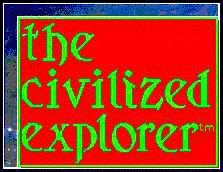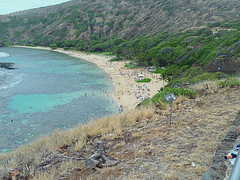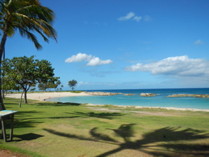
[Site TOC] [American vacations TOC]

We were invited by a friend to spend a week at a high-rise condo in Waikiki in June, 2012, so we accepted the invitation! We have photos and videos in our Honolulu set on flickr.
After years going to the Caribbean, we were pleasantly surprised by the comparative lack of blood sucking arthropods. It may have been our location in a high rise condo, but we slept with the windows open and no screens with nary a mosquito bite, and our only attacks from flying vampires was on Electric Beach when we were in the shade of a tree. Moving to the sun eliminated the bites. We got no bites at night, whether strolling the beaches, the boulevards, or the paths at the Polynesian Cultural Center.
We went to only three beaches during our stay. First up was Hanauma Bay, renowned for its snorkeling and recommended by all. Except us. Well, there are some caveats. Because it's renowned and recommended, everyone goes there. It's hard to snorkel without running into another human. The bay is a pleasant place, and it has showers and toilets. But it's so highly used by humans that you have to buy a ticket and watch a video to gain entry in the hopes that you won't destroy the reefs that make the bay so attractive to fish. We happened to hit it at low tide, and it was a real belly-scraper getting out into water deep enough to dive with the fishes. Our Honolulu set on flickr has a couple of photos and videos from Hanauma Bay. If you can, plan your visit for high tide. It seems safe and calm in the bay, and it's crawling with tourists of all ages, so children seem relatively safe in those waters.
 Hanauma Bay
Hanauma Bay
Safety is a factor at Electric Beach, though. The electric power plant is across the highway, giving the beach its name. The surf is not dangerous, but it's aggravating, and this is where you learn you shouldn't ever turn your back on the ocean. There was a small outflowing current when we were there, making it harder to swim in to the beach than it was to swim out. Not a burdensome swim in, but noticeable. Worse, the power plant exhausts its hot water into the ocean there, so you need to be careful where you snorkel. You may run into hot water which carries out into the ocean. We have videos and photos of the entry and of the flora and fauna there. It is a very good place to snorkel. It's considered beginner level, but be careful getting in and out.
The small beach is used by snorkelers and scuba divers, so there's lots of activity there, and there are dive boats off the beach as well. Snorkelers with dive flags and spearfishing gear were there in numbers. When you come in or out of the water be aware not only of the surf but of who is around you. There are no facilities, so if you want water or food, bring it with you. We were warned to be wary of thieves there.
Our next beach trip was to Lagoon 4 at the beaches with expensive all-inclusive resorts outside of Honolulu. You get to them on the same road as Electric Beach, but they're closer. The four lagoons are man-made, presumably for the benefit of the guests and the resorts and are available for all to use. The grass is well watered and manicured; there are facilities and a snack bar at the adjacent marina. The lagoon is dug out behind a sea wall, and the water is calm enough that toddlers and pre-schoolers were paddling around and playing in the water. There is a deeper area near the lagoon's outlet and lots of rock artfully laid around to give small fry fish a reason to be there. I don't consider it worthy of snorkeling, but if you have small children who want to snorkel, this is a place I'd recommend. Naturally, we have a photo or two in our Honolulu set.
 Lagoon 4.
Lagoon 4.
The Polynesian Cultural Center is a commercial theme park run by the Hawaii campus of Brigham Young University. Most of the workers there are students at the college. It may be worth an afternoon for you. The students put on mini-shows that demonstrate something about the many cultures that have spread across the Pacific, sometimes referred to as Polynesian or Oceania. The mini-shows vary in quality and emphasize audience participation. Our videos in our Honolulu set have a sample of one such show.
We had tickets for their evening big show and dinner. The dinner was the worst I've ever had to suffer through in a theme park. About a thousand people descend on the cafeteria, starting in a long line with groups allowed through as tables clear. Instead of one food line, there are several places to start, none of which is well-labeled as the start and none of which give you any indication of what is served in that line. As a result, you have hundreds of people wandering up and down the line trying to see what's available. I gave up and got some sliced ham, canned spaghetti, canned tomato paste, and canned corn. I looked at the deserts and passed. One of us tried the deserts and didn't finish (how is it possible to make a tasteless chocolate chip cookie?). I recommend skipping the mass dinner entirely. We didn't try their snack bars, but they can't have been worse.
The evening show was well-done. It's college kids, and it's on a good college level. The dancing is excellent, but someone tried to impose an uplifting script about the breath of life on what could have been a great display of cultural dances. Time was wasted trying to tell something about "native life" that could have been better spent showing culture instead. The fire dancing was some of the best we've seen, but it was saved until the end of the show, unfortunately.
Overall, the PCC is a commercial theme park with tons of souvenirs to separate you from your money and a gloss of commentary with each mini-show that doesn't really inform. (The emcee points to some stuff nailed to the walls of the sheds, for example, and tells you which island is represented. Then they perform.)
The highlight of our visit happened when we stumbled across some students rehearsing a show, and we stopped to watch. They needed some extras to participate, so we were invited in to be witnesses to a marriage ceremony. The kids were great -- friendly and polite -- and shepherded us through where we should stand and walk with the cast members. The best part of the visit was the unscripted time with the cast.
We visited Pearl Harbor, particularly the Battleship Missouri and the memorial to the USS Arizona. You stand around in the visitor center till the bus takes you to the entrance to the USS Missouri, then you walk over to the anchorage for the Missouri, they take your picture, and then you climb aboard. There is a short guided tour of the deck which fills you in on the history of the ship and its war time service. It's most-known as the ship on which Japan's representatives signed the surrender document at the end of World War II, but it served in Korea and the first Gulf War (sitting out the Vietnam War in mothballs). She's now retired from service and is a museum ship in Pearl Harbor.
The people who serve on her now are probably retired military, but whether former military or not, they're proud of the ship. If you have any interests even outside military service, I recommend asking if there is someone on board who is knowledgeable. We are ham radio operators, for example, and there is always a ham shack on museum ships, so we asked who could show it to us. This brought excited gleams to the eyes of some people who took us down to areas that are off-limits to the general public for a guided tour of the ship's radio rooms. The ship's callsign now is KH6BB (all battleships have a BB designation; the Missouri was BB-63). We had the ham-in-charge show us not only the gear in the ham shack, but representative radio equipment from World War II and the much more numerous radio communication equipment from the Gulf War. Again, photos in the Honolulu set. I was a Minuteman Missile Combat Crew Member back in the 70s, and I wear a patch about it on my photographer's vest. This was noticed, and we were pointed to the Combat Information Center and other Gulf War missile areas that the regular tour crowd missed. We got to try to open the special safe the nuclear codes were in, but nobody now knows the combination. We assume the safe is now empty, but who can tell?
Because the areas are off-limits, we had to have a guide with us at all times. We always ask about the ham shacks, and sometimes no one is there who can show us, but more often there is. And sometimes your guide has other interests to share with you. I greatly encourage you to ask the people who are now serving on the ship about whatever interests you and see where you get to go that's off the normal tours.
The USS Arizona was sunk in the surprise attack on Pearl Harbor on the seventh of December, 1941. The Battleship Arizona (BB-39) sank after being bombed, taking 1,177 souls on board with her; the total crew numbered 1,400. The wreck was not raised, and some of the bodies are still entombed there. The white memorial we see in photos straddles the hull which still lies on the harbor floor. Three officers were awarded the Medal of Honor for their service in the brief minutes between the beginning of the attack and her sinking. It is my understanding that the ship has been decommissioned from active service, that the US Navy retains title to the ship, but that control of the site has been given to the National Park Service, which provides staffing. The site is a national shrine and war grave, with the US flag flying above her at half-staff.
Our experience is limited, so beware of our comments. After years of associating "ABC" with "alcoholic beverage control," it was a pleasant surprise to find that in Hawaii, it's a chain of convenience stores. ABC stores were all over town, and their contents varied. In addition to the food, snacks, and beverages in most convenience stores, ABC has groceries, wine and liquor, souvenirs, clothes, and more. There was one near our condo, and we would stop there on our way back and pick up a morning pastry, soft drinks, or whatever. There was also a Costco in Honolulu that we stopped by.
Honolulu seems to be a mecca for Japanese tourists, and the shops cater to them very well, many with signs in Japanese and Japanese-speaking (if not natively, then fluently) staff. We have photos in our Honolulu set of Japanese couples in full bridal regalia being photographed on the beaches, so it seems to be a wedding destination in addition to tourism. There were several different tours with Japanese visitors to the Polynesian Cultural Center; be sure to see our video of the mini-show. Because of the world-wide tourism trade, Honolulu is a shopping paradise for ultra-high end items in addition to the more mundane needs of the locals.
Disappointingly, the restaurants didn't knock our socks off. I guess were accustomed to the fine dining and service from the French West Indies. Our wait-staff at restaurants in Honolulu were generally people from the mainland US whose interest seemed to be to provide adequate service under rushed conditions. I don't recall what we ate, although burgers seemed to be offered at most places, and I tried a few. Often our waiters or waitresses were delayed or brought the wrong drinks or orders. We had dinner at La Mer, a restaurant in the Halekulani Hotel. Even at that high-end restaurant, the person who brought our food put the other person's order in front of us in every course. So I'd summarize our dining experiences as "nothing was bad, but nothing was memorable."
Copyright © 2012, The Civilized Explorer. All rights reserved.